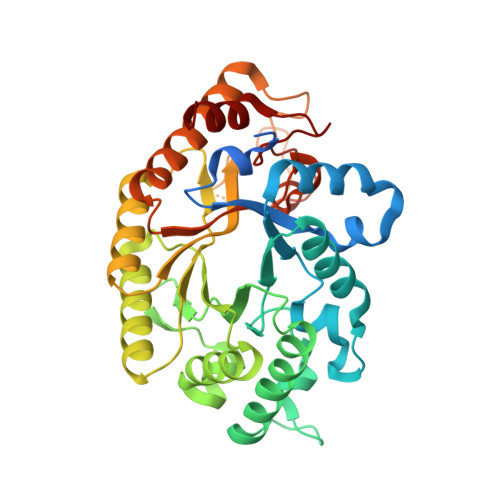Development and biotechnological application of a novel endoxylanase family GH10 identified from sugarcane soil metagenome.
Alvarez, T.M., Goldbeck, R., dos Santos, C.R., Paixao, D.A., Goncalves, T.A., Franco Cairo, J.P., Almeida, R.F., de Oliveira Pereira, I., Jackson, G., Cota, J., Buchli, F., Citadini, A.P., Ruller, R., Polo, C.C., de Oliveira Neto, M., Murakami, M.T., Squina, F.M.(2013) PLoS One 8: e70014-e70014
- PubMed: 23922891
- DOI: https://doi.org/10.1371/journal.pone.0070014
- Primary Citation of Related Structures:
4K68 - PubMed Abstract:
Metagenomics has been widely employed for discovery of new enzymes and pathways to conversion of lignocellulosic biomass to fuels and chemicals. In this context, the present study reports the isolation, recombinant expression, biochemical and structural characterization of a novel endoxylanase family GH10 (SCXyl) identified from sugarcane soil metagenome. The recombinant SCXyl was highly active against xylan from beechwood and showed optimal enzyme activity at pH 6,0 and 45°C. The crystal structure was solved at 2.75 Å resolution, revealing the classical (β/α)8-barrel fold with a conserved active-site pocket and an inherent flexibility of the Trp281-Arg291 loop that can adopt distinct conformational states depending on substrate binding. The capillary electrophoresis analysis of degradation products evidenced that the enzyme displays unusual capacity to degrade small xylooligosaccharides, such as xylotriose, which is consistent to the hydrophobic contacts at the +1 subsite and low-binding energies of subsites that are distant from the site of hydrolysis. The main reaction products from xylan polymers and phosphoric acid-pretreated sugarcane bagasse (PASB) were xylooligosaccharides, but, after a longer incubation time, xylobiose and xylose were also formed. Moreover, the use of SCXyl as pre-treatment step of PASB, prior to the addition of commercial cellulolytic cocktail, significantly enhanced the saccharification process. All these characteristics demonstrate the advantageous application of this enzyme in several biotechnological processes in food and feed industry and also in the enzymatic pretreatment of biomass for feedstock and ethanol production.
Organizational Affiliation:
Laboratório Nacional de Ciência e Tecnologia do Bioetanol (CTBE), Centro Nacional de Pesquisa em Energia e Materiais (CNPEM), Campinas, São Paulo, Brasil.















